Gateway and Acer Netbooks: Wonder Twin Powers, Activate!
by Vivek Gowri on April 28, 2010 2:22 AM ESTScreen Analysis
The screen is pretty average, not standing out in any category. This continues an unfortunate trend of mediocrity in the LCD panels used in mobile computers. As shown by the iPad, a high quality can really enhance or even define the experience of a device, and that's one aspect of the 1001P that really trumps these two devices. With both the matte finish and super high contrast ratio, the Eee is on an entirely different level than the Gateway and Acer.
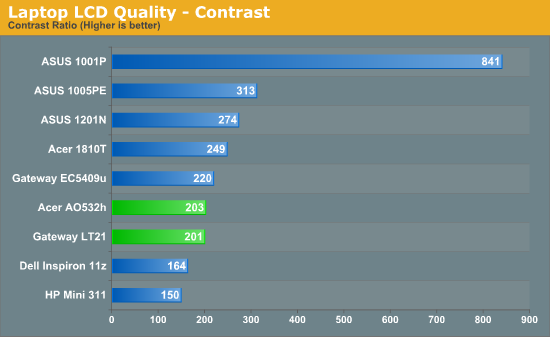
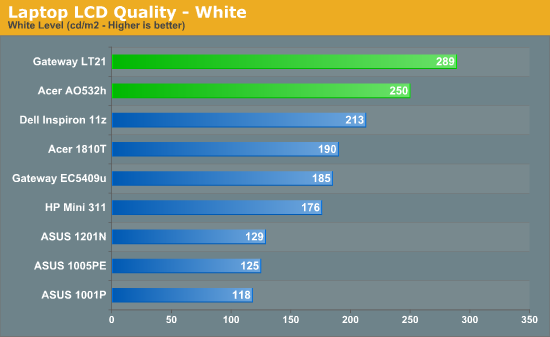
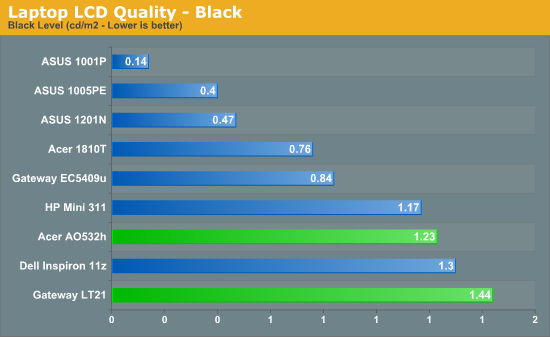
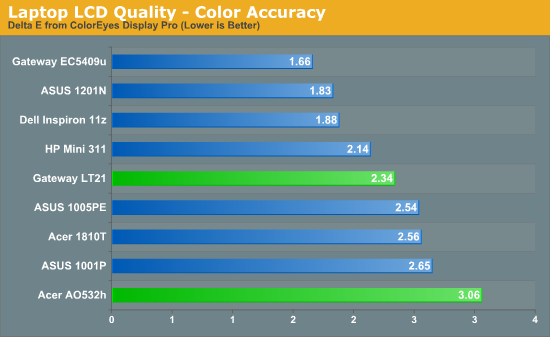
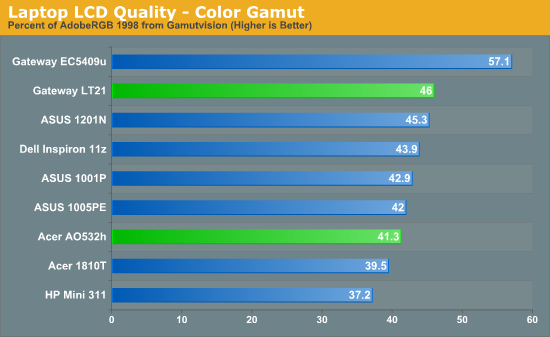
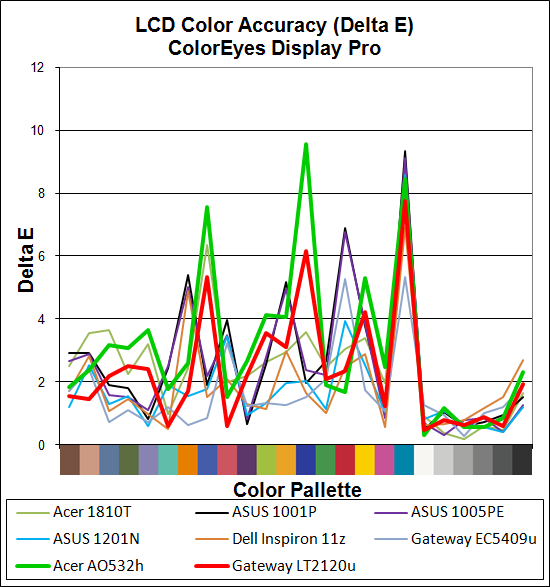
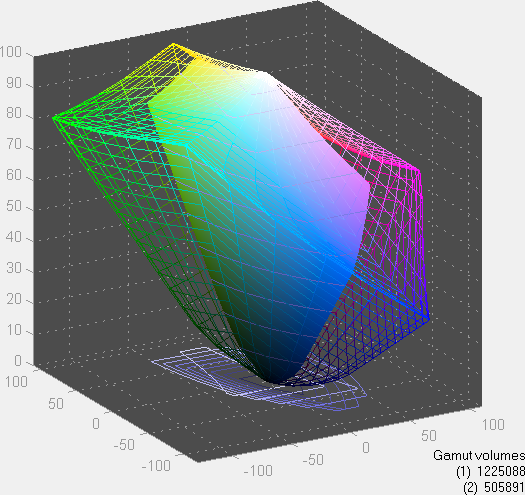
Acer Gamut
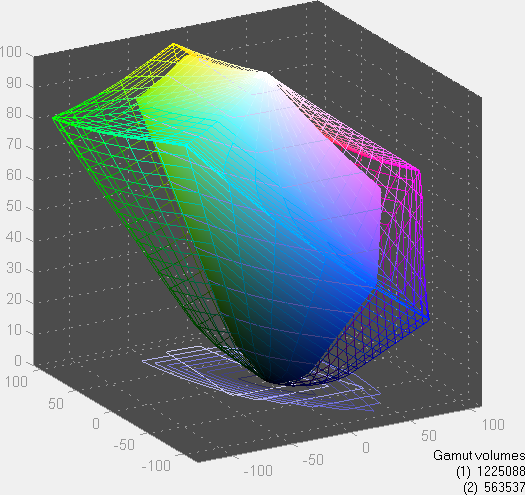
Gateway Gamut
These two fall right in line with most other consumer-level notebooks in terms of display quality. This continues an unfortunate trend towards poor quality screens for the sake of cost cutting measures, with few exceptions (as mentioned, the 1001P, along with some larger media and gaming laptops). Unfortunately, what most manufacturers (and consumers) should realize is that the display is one of the single most important parts of any mobile device, being the main method for interaction between user and computer. We can’t criticize Acer specifically here for the poor LCD—it’s an industry-wide trend that is disappointing overall. What we want is 1001P contrast levels, preferably with greater than 200nits maximum brightness. Only when we have that is it worth discussing color gamut and accuracy… and honestly, color accuracy isn't a major concern for any netbook.










15 Comments
View All Comments
JarredWalton - Wednesday, April 28, 2010 - link
I've got a couple AMD-based laptop reviews in the works. Vivek will be getting the Acer Ferrari One this week (CULV alternative), and I've got M300 and M600 laptops to compare with an i3-430m setup. Honestly, other than a lower price AMD laptops are still a tough sell in my book. The better IGP still isn't that great; the Intel HD i3/i5 IGP is good enough for anything but gaming, while the HD 4200 needs low detail and 800x600 resolution to be playable in most titles. Couple that with generally lower performance and battery life and there's not a lot of benefit.CULV with a discrete GPU can give you better battery life and gaming performance if that's what you're after, though it will cost (a lot) more. At that point, the CULV + Optimus laptops end up being the best recommendation. So the choice is pretty much 8 hours battery life with 4500MHD (Intel CULV) or 4 hours battery life with HD 4200 (AMD), for around $400-$600.
jaydee - Wednesday, April 28, 2010 - link
But I think the ASUS Eee PC 1201T w/AMD mv-40 (http://www.newegg.com/Product/Product.aspx?Item=N8... could give the traditional Atom-based netbook a good run for it's money.About $60 more and you get 12" screen, 1366x768 resolution, 2GB of RAM, HDMI out, stronger CPU and much stronger integrated graphics. You lose on battery life, and doesn't come with an OS, but for people with extra WinXP licenses or wanting to put Linux on it, I think it provides a much stronger value than the above Acer/Gateway twins, don't you think?
How would it compare to Atom+Ion? It'll still be cheaper, but should even out the battery life.
hybrid2d4x4 - Wednesday, April 28, 2010 - link
Hey, I just wanted to throw out a suggestion for the firefox sqlite issue: install a RAMdrive app (I use Dataram RAMDisk - it's free and works flawlessly, even with win7 x64) and move your profile to the RAM drive. I did this on my HTPC as this is something that has been nagging me with a WD Green drive where the drive would noticeably lag when the head is unloaded and I start typing into the address bar. The time to generate "suggestions" as you type is now instantaneous! You can configure it to load the image on startup and save it on shutdown, so it works exactly like normal, but the only time it accesses the HDD is on startup/shutdown. It also saves you the wear of the very frequent unnecessary random writes to the HDD every time you load a page or reads when it fills in what you type.Having said that, I would also like to see how SSDs would fare in laptops, and in addition to your suggestions, I hope that Anand would also throw a typical 2.5" HDD into the SSD power charts as a reference for those of us considering SSD swaps into laptops.
m4nm4n - Wednesday, April 28, 2010 - link
If I had these connected to my Wifi router, the router would be named Gleek.popej - Thursday, June 24, 2010 - link
You wrote: "we don't know if the ASUS laptops are truly more energy efficient".You probably use ASUS Super Hybrid Engine in auto mode. When running on battery SHE cripple notebook performance. CPU and RAM frequency is reduced by 20% and battery life is longer.
I think it is a flaw in your test, that you don't check performance when on battery.